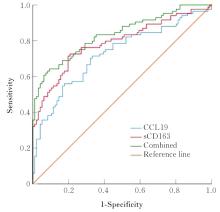| [1] |
Fang LIU,Jie ZHAO,Xiujuan CHEN,Saren WANG,Zeli TIAN,Shufang LI,Jing XI,Qin ZHANG.
Effect of body mass index on pregnancy outcomes of patients with long regimen controlled ovarian hyperstimulation underwent fresh and freeze-thawed embryo transfer cycles
[J]. Journal of Jilin University(Medicine Edition), 2023, 49(6): 1547-1553.
|
| [2] |
Qinghua PING,Wenjing ZHU,Jianxin XIA.
Pustular psoriasis treated with secukinumab during pregency: A case report and literature review
[J]. Journal of Jilin University(Medicine Edition), 2023, 49(6): 1599-1603.
|
| [3] |
Yaping YE,Yanfeng FAN,Lu DING,Longmei WANG,Ping LI.
Effects of different serum levels of anti-mullerian hormone on pregnancy outcome of patients with polycystic ovary syndrome
[J]. Journal of Jilin University(Medicine Edition), 2023, 49(2): 501-507.
|
| [4] |
Dan WENG,Haixia DUAN.
Risk of ectopic pregnancy in patients with IVF-ET predicted with nomogram model based on multiple influencing factors
[J]. Journal of Jilin University(Medicine Edition), 2023, 49(1): 158-165.
|
| [5] |
Yang BAI,Chenxi YANG,Xiaoqiang LIU,Yu LIU,Qian XING.
Changes of follicular helper T lymphocytes in peripheral blood of patients with systemic lupus erythematosus during pregnancy and its significance
[J]. Journal of Jilin University(Medicine Edition), 2023, 49(1): 166-172.
|
| [6] |
Hong GAO,Li LIN,Xiaohong YAN,Ping TAO,Youzhu LI.
Effect of transient prematur of luteinizing hormone in gonadotropin releasing hormone antagonist flexible protocols on pregnancy outcomes of patients underwent fresh IVF/ICSI-ET cycles
[J]. Journal of Jilin University(Medicine Edition), 2022, 48(6): 1566-1573.
|
| [7] |
Hong GAO,Xiaohong YAN,Li LIN,Lulu REN,Youzhu LI.
Analysis of risk factors of late spontaneous abortion after assisted reproductive technology-assisted pregnancy
[J]. Journal of Jilin University(Medicine Edition), 2022, 48(5): 1298-1304.
|
| [8] |
Xiangguo CONG,Xinxin CHEN,Ying WU,Mengdie CAO,Shuxiang LI,Lei CHEN,Qiong SHEN.
Associations of serum iodine and iron levels with thyroid function and thyroid antibodies during early pregnant women
[J]. Journal of Jilin University(Medicine Edition), 2022, 48(4): 988-994.
|
| [9] |
Xiaoyu HOU,Ya LI,Jiangyan XIE,Yian SONG,Jie ZHANG,Jianhui XU.
Effect of pregnancy on cold defense-induced interscapular brown adipose tissue thermogenesis in famale rats and its mechanism
[J]. Journal of Jilin University(Medicine Edition), 2022, 48(3): 553-560.
|
| [10] |
Yuanyuan YE,Xiaohong YAN,Youzhu LI.
Analysis on related factors of pregnancy outcome after fresh embryo transfer in in-vitro fertilization/ intra-cytoplasmic sperm injection
[J]. Journal of Jilin University(Medicine Edition), 2022, 48(2): 454-461.
|
| [11] |
Danni QU, Peng WANG, Yuan LI.
Application of gonadotropin-releasing hormone agonist inluteal support of patientswith in?vitro fertilization-embryo implantation
[J]. Journal of Jilin University(Medicine Edition), 2021, 47(3): 701-706.
|
| [12] |
WANG Lei, YAN Xiaohong, LIN Li, LI Youzhu.
Effect of preparation plan of hormone replacement after down-regulation on pregnancy outcome of frozen-thawed embryo transfer cycle in advanced age infertile patients
[J]. Journal of Jilin University(Medicine Edition), 2020, 46(04): 810-815.
|
| [13] |
LI Huan, YIN Xiaoting, QIAN Honghao, ZHANG Jing.
Effects of lead exposure during pregnancy and lactation periodson learning and memory abilities of offspring rats and their mechanisms
[J]. Journal of Jilin University(Medicine Edition), 2020, 46(02): 352-358.
|
| [14] |
LIU Yu, REN Xue, SUN Yue, YANG Chenxi, XU Qian.
Diagnosis and treatment of novel coronavirus pneumonia in pregnancy with gastrointestinal symptoms as first manifestations
[J]. Journal of Jilin University(Medicine Edition), 2020, 46(02): 408-412.
|
| [15] |
SHI Yan, SUN Yan, SHI Guang, YU Qiong, TANG Yan.
Systemic lupus erythematosus complicated with autoimmune hypoglycemia with pancytopenia as first manifestation: A case report and literature review
[J]. Journal of Jilin University(Medicine Edition), 2020, 46(01): 164-168.
|
 )
)





